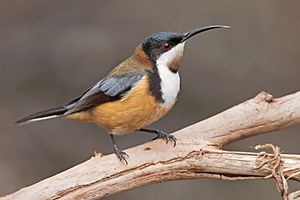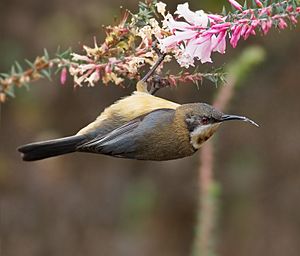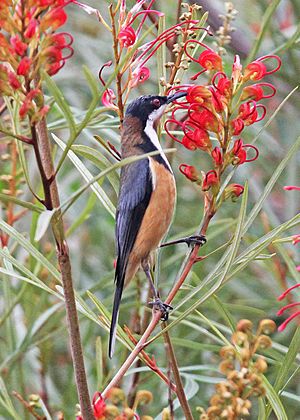Eastern spinebill facts for kids
Quick facts for kids Eastern spinebill |
|
|---|---|
 |
|
| Male | |
 |
|
| Female | |
| Conservation status | |
| Scientific classification | |
| Subspecies | |
|
Acanthorhynchus tenuirostris cairnsensis |
The eastern spinebill (Acanthorhynchus tenuirostris) is a cool type of honeyeater bird. You can find it in south-eastern Australia, living in forests, woodlands, and even gardens in cities like Canberra, Sydney, and Melbourne. This bird is about 15 cm long and has special black, white, and chestnut feathers. It also has bright red eyes and a long, curved bill, which helps it drink nectar from flowers!
Contents
About the Eastern Spinebill's Name
Scientists give every animal a special two-part name, like Acanthorhynchus tenuirostris for the eastern spinebill. This helps everyone around the world know exactly which animal they are talking about.
How the Eastern Spinebill Got Its Name
The eastern spinebill was first described by an English bird expert named John Latham in 1801. Its scientific name, Acanthorhynchus tenuirostris, comes from ancient Greek and Latin words.
- Acantho- means 'spine' in Greek.
- Rhynchos means 'bill' in Greek.
- Tenuis means 'narrow' in Latin.
- Rostrum means 'bill' in Latin.
So, its name basically means "spine-billed with a narrow bill"! People sometimes call it the spine-billed honeyeater or awl-bird too.
Eastern and Western Spinebills
The eastern spinebill has a close relative called the western spinebill, which lives in Western Australia. Scientists think these two birds came from the same ancestor bird a long, long time ago. Climate changes, like deserts forming, separated their populations. Over time, they slowly changed and became the two different spinebill species we see today.
What the Eastern Spinebill Looks Like
The male eastern spinebill is about 13 to 16 cm long. It has a long, thin, black bill that curves downwards. Its head is black, and it has a white throat with a chestnut-colored patch. Its eyes are red! The back of its neck is brownish-red, its back is grey-brown, and its belly is a pale cinnamon color. Its dark tail has white tips on the sides.
Female eastern spinebills are a bit smaller and their colors are not quite as bright as the males. Young spinebills are pale cinnamon underneath and grey-brown on top, with brown-red eyes and an orange base to their bill.
What Does It Sound Like?
The eastern spinebill has a clear, high-pitched call that sounds like "chip-chip-chip." It often repeats this sound for a long time.
Where Eastern Spinebills Live
Eastern spinebills live in dry forests, scrublands, and heathlands. You can find them from the Cooktown area in North Queensland, all the way south through New South Wales (east of the Great Dividing Range), Victoria, and into the Flinders Ranges in eastern South Australia. They also live all over Tasmania.
These birds are very good at adapting to different places. They can even live in city gardens if there are enough plants for them to hide in and find food.
Eastern Spinebill Families
Eastern spinebills usually breed between August and January. They can raise one or two families during this time.
Building a Nest
Their nest is shaped like a deep cup and is made from grass and strips of bark. They line the inside with soft feathers and plant fibers to make it cozy. The nest hangs by its rim in the fork of a small, bushy tree or shrub, usually about 1 to 15 meters above the ground.
Eggs and Chicks
A female spinebill usually lays one to four eggs, but two is most common. The eggs are pinkish with dark reddish-brown spots and blotches, and they are about 17 mm by 13 mm in size. The female sits on the eggs to keep them warm for about 13 to 16 days until they hatch. Both parents work together to feed the baby chicks and keep the nest clean.
What Eastern Spinebills Eat
Eastern spinebills love to drink nectar from many different flowers. They especially enjoy nectar from:
- Gum trees
- Mistletoes (Amyema species)
- Epacris longiflora
- Epacris impressa
- Correa reflexa
- Many plants from the Proteaceae family, like Banksia ericifolia, Banksia integrifolia, Lambertia formosa, and Grevillea speciosa.
They also eat small insects and other tiny creatures.
Sometimes, there isn't much nectar available. When this happens, eastern spinebills have a clever way to cope. They might store fat when there's plenty of nectar, spend more time looking for food, or even lower their body's energy use during the day to save energy.
See also
 In Spanish: Picoespina oriental para niños
In Spanish: Picoespina oriental para niños



